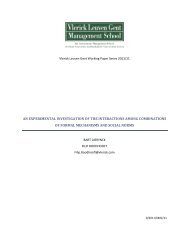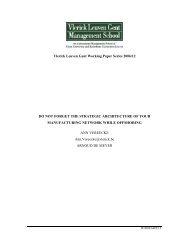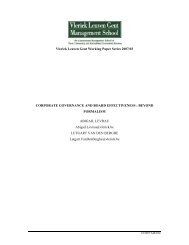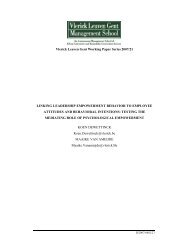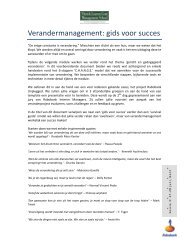innovation and internationalization by indian firms - Vlerick Public
innovation and internationalization by indian firms - Vlerick Public
innovation and internationalization by indian firms - Vlerick Public
Create successful ePaper yourself
Turn your PDF publications into a flip-book with our unique Google optimized e-Paper software.
only in emerging markets that had developed further, but also in key industries in developed<br />
markets.<br />
Despite these successes, Indian MNEs still had some limitations however. In some developed<br />
markets, Indian <strong>firms</strong> lacked competitiveness or faced tougher institutional environments than at<br />
home <strong>and</strong> were thus unable to compete (for example, the pharmaceutical industry’s expansion in<br />
the US has not been as successful as those into emerging markets, where Indian <strong>firms</strong> have often run<br />
into trouble with regulatory bodies such as the US Food <strong>and</strong> Drug Administration). There were also<br />
challenges in specific industries in specific emerging markets. For example, Indian pharmaceutical<br />
<strong>firms</strong> faced tough competition from Western <strong>firms</strong> <strong>and</strong> regulations favouring local Chinese<br />
companies in China. Several Indian <strong>firms</strong> that had entered China in the early 2000s were forced to<br />
scale back efforts in 2009-2011.<br />
CONCLUSION: LESSONS LEARNED AND THE WAY AHEAD<br />
Innovation <strong>and</strong> <strong>internationalization</strong> <strong>by</strong> Indian <strong>firms</strong> has changed significantly over the last<br />
two decades. In this time, continued development in India has removed some institutional voids,<br />
though not all. Further, Indian MNEs have evolved <strong>and</strong> are no longer solely reliant on their domestic<br />
markets. Some, such as the Tata group, now generate more revenue from overseas markets than<br />
from their home market. This also applies to several pharmaceutical <strong>firms</strong>. Such <strong>firms</strong> increasingly<br />
resemble international players, competing in India <strong>and</strong> abroad. As the competitive <strong>and</strong> institutional<br />
context, both in India <strong>and</strong> outside, has changed, <strong>firms</strong> have adjusted their strategies to compete in<br />
newer ways.<br />
Indian <strong>firms</strong>’ strategies on <strong>innovation</strong> <strong>and</strong> <strong>internationalization</strong> have become increasingly<br />
complex <strong>and</strong> increasingly involve a mix of asset-seeking <strong>and</strong> market-seeking rationales. Several<br />
leading Indian <strong>firms</strong> are now listed overseas <strong>and</strong> are able to access international capital. They have<br />
established research <strong>and</strong> development centres of excellence in developed markets. Learning from<br />
these experiences (both successful <strong>and</strong> unsuccessful), Indian <strong>firms</strong> are now engaging in higher<br />
technology <strong>innovation</strong> both in India <strong>and</strong> overseas with a view to targeting the high end of developed<br />
markets. For example, Suzlon, the Indian alternative energy firm, started off in 1995 with basic<br />
technology to counter soaring power costs <strong>and</strong> the infrequent availability of power in the Indian<br />
state of Gujarat. It is now the world’s third largest wind power equipment manufacturer. It has R&D<br />
centres in Belgium, Denmark, Germany, India <strong>and</strong> the Netherl<strong>and</strong>s, <strong>and</strong> manufacturing facilities on<br />
three continents. India is now also a hub for small cars, <strong>and</strong> Chennai is referred to as the Detroit of<br />
14



